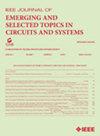A Low Thermal Sensitivity Subthreshold-Current to Pulse-Frequency Converter for Neuromorphic Chips
IF 3.8
2区 工程技术
Q2 ENGINEERING, ELECTRICAL & ELECTRONIC
IEEE Journal on Emerging and Selected Topics in Circuits and Systems
Pub Date : 2023-10-02
DOI:10.1109/JETCAS.2023.3321105
引用次数: 0
Abstract
To convert a subthreshold current to a pulse frequency efficiently and predictably, we designed a silicon soma that conserves energy with current feedback and lessens thermal sensitivity with voltage feedback. When the input current charges a capacitor close to the inversion point of an inverter, its short-circuit current wastes energy. To shorten this period, existing designs accelerate the charging rate with positive feedback: Either a capacitive divider feeds back voltage or a current mirror feeds back current. Voltage feedback is less effective because it kicks in only at the inversion point. Current feedback is less predictable because its leakage current is exponentially sensitive to temperature variation. By quantifying this thermal sensitivity with an analytic model of the subthreshold MOS transistor, we successfully combined current feedback with voltage feedback to design a silicon soma 10-fold less sensitive to temperature than a previous current-feedback-only design that uses 7.6-fold more silicon area. This advance allowed a mixed-signal neuromorphic chip to be predictably programmed for the first time.用于神经形态芯片的低热灵敏度阈下电流脉冲频率转换器
为了高效、可预测地将阈下电流转换为脉冲频率,我们设计了一种硅体,它通过电流反馈节省能量,通过电压反馈降低热敏感性。当输入电流对接近反相器反相点的电容器充电时,其短路电流会浪费能量。为了缩短这段时间,现有设计通过正反馈加快充电速度:要么是电容分压器反馈电压,要么是电流镜反馈电流。电压反馈的效果较差,因为它只在反相点起作用。电流反馈的可预测性较差,因为其泄漏电流对温度变化呈指数级敏感。通过使用亚阈值 MOS 晶体管的分析模型量化这种热敏感性,我们成功地将电流反馈与电压反馈结合起来,设计出了一种对温度敏感性比以前的纯电流反馈设计低 10 倍的硅 Soma,其硅面积比以前的设计大 7.6 倍。这一进步首次实现了混合信号神经形态芯片的可预测性编程。
本文章由计算机程序翻译,如有差异,请以英文原文为准。
求助全文
约1分钟内获得全文
求助全文
来源期刊

IEEE Journal on Emerging and Selected Topics in Circuits and Systems
ENGINEERING, ELECTRICAL & ELECTRONIC-
CiteScore
8.50
自引率
2.20%
发文量
86
期刊介绍:
The IEEE Journal on Emerging and Selected Topics in Circuits and Systems is published quarterly and solicits, with particular emphasis on emerging areas, special issues on topics that cover the entire scope of the IEEE Circuits and Systems (CAS) Society, namely the theory, analysis, design, tools, and implementation of circuits and systems, spanning their theoretical foundations, applications, and architectures for signal and information processing.
 求助内容:
求助内容: 应助结果提醒方式:
应助结果提醒方式:


